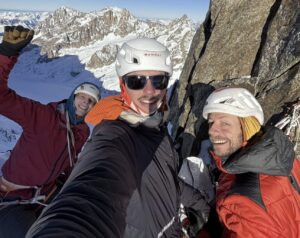You wouldn’t imagine there’d still be a major new route on what is probably the best-known peak in the Alps. Even Francois Cazzanelli found it hard to believe that a 500m dihedral rising on the south face of the Matterhorn — known as Cervino from its Italian side — was still untouched.
“I saw the line in autumn as I was training on skis with my cousin, Stefano Stradelli,” he told ExplorersWeb in an exclusive interview. “I was amazed when I realized that such an obvious line was not yet opened.”
The dihedral lies between Picco Muzio (4,187m) and the Pilastro dei Fiori. It is topped by a huge block of rock.

Route topo by Francois Cazzanelli.
Three friends
“I talked with my friend, Marco Farina, and we decided to try this perfect line,” said Cazzanelli. And of course, my cousin Stefano was on the team as well. Jerome [Perruquet] also joined.”
Cazzanelli said that one of the best things about the climb was that he went with three of his best friends.
“We had to wait for the right conditions,” he explained. This mixed route on the south side requires very low temperatures or at least a cloudy day on which no sun hits the wall and destabilizes the ice, causing avalanches and rockfall from above.

The four friends. Photo: Francois Cazzanelli
The route
The first part is a 300m snow couloir that leads to the second part: the big dihedral some 500m long. It’s 11 pitches in total. Nine of them are mixed climbing, involving ice and dry tooling, and two pitches are pure rock climbing, Grade 6b. Rather than a very technically difficult route, I’d say it is an impressive one. The climb up the dihedral is an off-width, and it is Cervino. I never thought it was possible to climb an off-width on Cervino but hey, there it was.
Cazzanelli adds: “When we started the project, we did not have a clear idea of the best tactical approach. In the beginning, we considered spending two days on the wall with a bivy, but that proved not an option due to the constantly changing weather.”

At the dihedral. Photo: Francois Cazzanelli
The first good day came on Jan. 31. “We climbed the first eight pitches in a very long, hard day,” said Cazzanelli. “That was enough to convince us that the project was possible. The rest of the line was clearly doable.”
The climbers didn’t fix any ropes or leave anything on the wall. They free-climbed that part of the route, with no bolts or permanent gear. “At the end of that initial day, we brought all the gear and ropes back home,” Cazzanelli noted.

One of the pitches at the dihedral. Photo: Damiano Levati
The second push
On Feb. 8, the day to attempt the entire route came. The team started at 6 am.
“We climbed the eight pitches we already knew really fast,” Cazzanelli recalls. “In just five hours, we reached the top of [that] part.”
On the trial climb, they reached the top of the 8th pitch at 6 pm. “This time it was 11 am…We had plenty of time to climb the four remaining pitches,” said Cazzanelli.

At the end of the first section. Photo: Damiano Levati
The two next pitches were hard and really impressive. On the third new pitch, the technical difficulty decreased but required navigating on quite poor rock. It was more a psychological endurance challenge on exposed terrain.
Luckily, the bitter cold was our ally, and everything stayed in place. The final pitch is super cool! We passed just under a big block stuck on the top of the dihedral. Past the block, you get to the top of the Pilastro dei Fiori, and into the sun.
“Marco, Jerome, and I opened four pitches each,” said Cazzanelli. “Stefano assumed the hardest work, climbing with a heavy backpack. He showed a great spirit of sacrifice for the entire team. It’s thanks to him that the project succeeded.”
They didn’t continue to the top of the Matterhorn but rappeled down from the top of the route.

On mixed terrain. Photo: Damiano Levati
Future plans
The climbers suggest ranking the 800m route R4, M7, 6B. They named it Una Follia per Adriana (“A crazy thing for Adriana”), in honor of Adriana Pession, who worked most of her life as Secretary of the Società Guide del Cervino. She died in 2021.
Cazzanelli is currently combining his training and climbing with his work as a guide and a rescuer. He is also the father of a two-month-old baby. Yet he told ExplorersWeb that he will find some time to return to the Himalaya this year.






